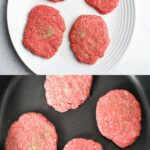Custard, that creamy and comforting dessert, is a timeless favorite enjoyed by people of all ages. While store-bought varieties are readily available, there’s nothing quite like the satisfaction of whipping up a batch of homemade custard from scratch. This guide delves into everything you need to know about custard, from its history and variations to a foolproof recipe in Urdu and some helpful FAQs.
A Brief History of Custard

Custard’s origins can be traced back to ancient Rome, where a similar dish called “puls” was made with eggs and milk. Over time, the recipe evolved and spread throughout Europe, taking on regional variations. In the 15th century, sweetened custards became popular, often flavored with spices and citrus. Today, custard remains a beloved dessert enjoyed in countless ways around the world.
Types of Custard
The world of custard offers a delightful variety to explore. Here are some of the most common types:
Baked Custard: This classic version is cooked in a water bath, resulting in a smooth and silky texture.
Easy Homemade Custard Recipe (Urdu)
Now, let’s get down to the delicious part: making your own homemade custard! This recipe is simple to follow and yields a creamy and flavorful custard perfect for any occasion.
Ingredients:
4 large eggs
Instructions:
1. In a large bowl, whisk together the eggs and sugar until well combined and slightly lighter in color.
2. In a separate saucepan, heat the milk over medium heat until just simmering. Do not let it boil.
3. Slowly whisk the hot milk into the egg mixture in a steady stream, whisking constantly to prevent the eggs from cooking.
4. Stir in the vanilla extract (or cardamom) and nutmeg (if using).
5. Strain the custard mixture through a fine-mesh sieve to remove any lumps.
6. Pour the custard into oven-safe ramekins or a baking dish.
7. Place the ramekins or baking dish in a larger baking pan and fill the pan with enough hot water to reach about halfway up the sides of the ramekins/dish. (This creates a water bath that helps the custard cook evenly.)
8. Bake at 350°F (175°C) for 40-45 minutes, or until a toothpick inserted into the center comes out clean.
9. Remove the custard from the water bath and let it cool completely at room temperature.
10. Once cool, cover the ramekins/dish with plastic wrap and refrigerate for at least 2 hours, or preferably overnight, to allow the custard to set completely.
11. Serve chilled, dusted with a sprinkle of nutmeg (optional).
Nutrition Facts (Per Serving)
Calories: 250
Please note: These are approximate nutrition facts and may vary depending on the specific ingredients used.
Conclusion
Homemade custard is a delightful and versatile dessert that can be enjoyed plain, topped with fresh fruit, or used as a base for other desserts. The recipe provided is a great starting point, and you can experiment with different flavors and variations to create your own signature custard. So, grab your ingredients, preheat your oven, and get ready to indulge in a taste of creamy goodness!
Frequently Asked Questions (FAQs)
1. Can I use skim milk instead of whole milk in this recipe?
Yes, you can use skim milk for a lighter custard. However, the texture may be slightly less creamy. You may want to add a tablespoon of melted butter to the custard mixture for a richer flavor.
2. My custard curdled. What went wrong?


